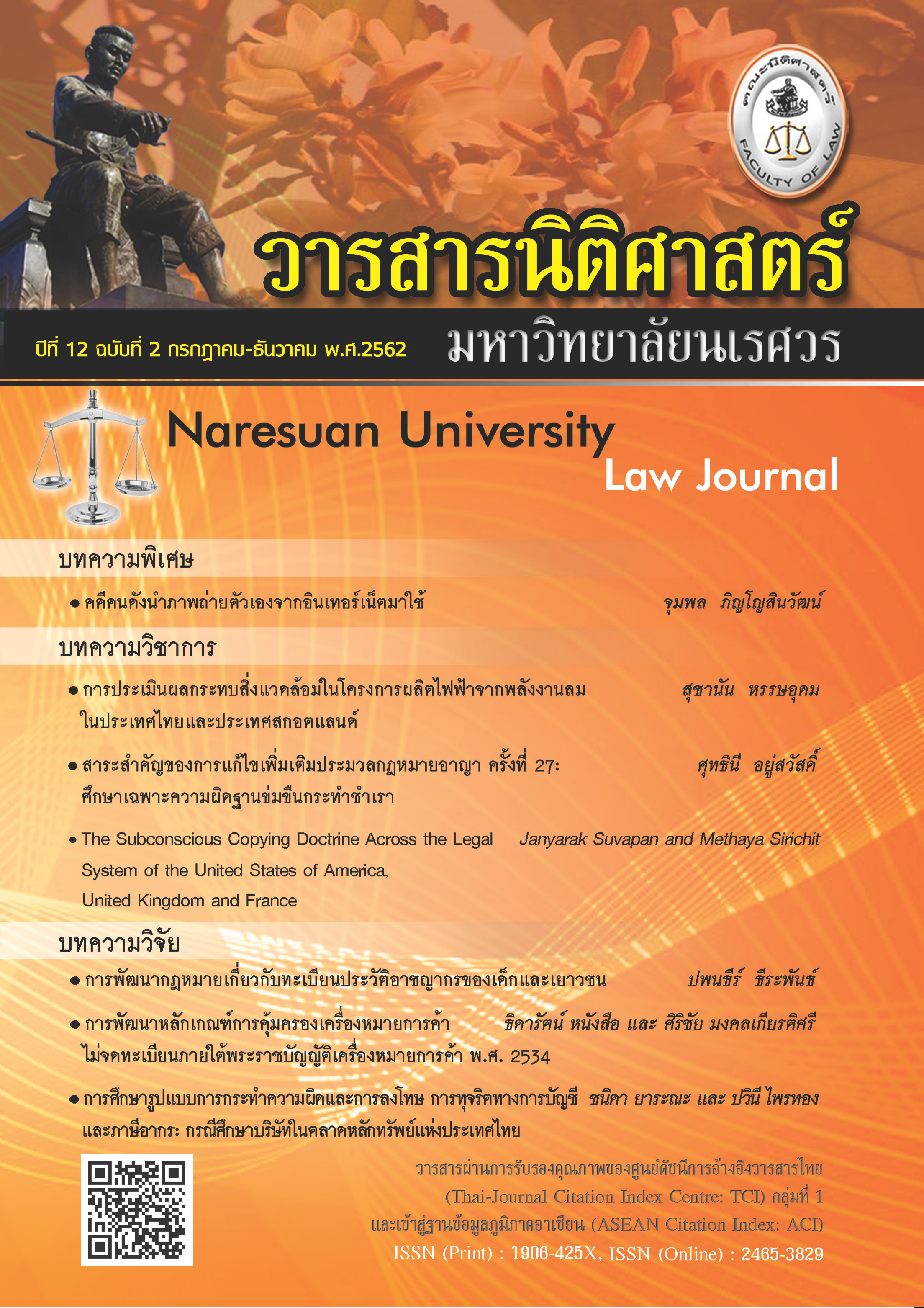The Subconscious Copying Doctrine Across the Legal System of the United States of America, United Kingdom and France
Main Article Content
Abstract
A person who copies the work of another infringes their copyright in that work. This absolute right was articulated in the seminal US case, Fred Fisher Inc., v. Dillingham, which held that the “author’s copyright is an absolute right to prevent others from copying his original collocation of words or notes, and does not depend upon the infringer’s good faith.” Thus, infringement may occur consciously or subconsciously.
This article is a comparative analysis of the doctrine of subconscious copying across the legal systems of the United States of America, the United Kingdom and France. First, it explains the legal standard for proving copyright infringement namely proof of access and proof of substantial similarity. Second, it analyzes the doctrine of subconscious copying in the different legal systems. It concludes that a person be held liable for copyright infringement by reason of subconscious copying.
Article Details
References
Brent, Debra Presti. “The Successful Musical Copyright Infringement Suit: The Impossible
Dream.” University of Miami Entertainment & Sports Law Review 7 (1990): 229-253.
Brown, Andrew. “Proof of Copying.” Last modified July 16, 2000. Accessed September
2, 2019. https://andrewbrown.co.nz/media/1062/proof-of-copying.pdf.
Brown, Isobel. “Sound Familiar? The “Chariots of Fire” Case.” European Intellectual
Property Review 8 (1987): 244-246.
Cadwell, Jeffrey. “Expert Testimony, Scenes a Faire, and Tonal Music: A (Not So) New
Test for Infringement.” Santa Clara Law Review 43, no. 1 (2005): 137-170.
Colombet, Claude. Propriété littéraire et artistique at droits voisins. Paris: Edition Dalloz,
1997.
Crowe, Carolyn. “The Song You Write May Not Be Your Own!: Proving Musical Copyright
Infringement: A Review of Gondos v. Hardy; Gondos v. Toth.” Intellectual Property
Journal 1 (1984-85): 4.
Feldman, Robin. “The Role of the Subconscious in Intellectual Property Law.” Hastings
Science and Technology Law Journal 2, no. 1 (2010): 1-24.
Fitzgerald, Anne. Intellectual Property Law. NSW: LBC Information Services, 1999.
Fruehwald, Scott E. “Copyright Infringement of Musical Compositions: ‘A Systematic
Approach’.” Akron Law Review 26 (1992): 15-41.
Garnett, Kevin. Copinger and Skone James on Copyright (Vol. 1), eds. Kevin Garnett, Gillian Davies and Gwilym Harbottle, 16th ed. London: Sweet & Maxwell, 2010.
Goldstein, Paul. Copyright: Principles, Law, and Practice. Boston: Little, Brown & Co. 1989.
Hastie, Peter. “The Concept of Subconscious Copying: Substantive Law and an Evidentiary Notion.” Australian Intellectual Property Journal 6 (1995): 16.
Hollingsworth, Joel S. “Stop me if I’ve heard this already: The Temporal Remoteness Aspect of the Subconscious Copying Doctrine.” Hastings Communications and Entertainment Law Journal 23 (2001): 457-476.
Jung, Carl G., M. -L. von Franz, Joseph L. Henderson, Jolande Jacobi, and Aniela Jaffé. Man and his Symbols. New York: Doubleday, 1964.
Keyt, Aaron. “An Improved Framework for Music Plagiarism Litigation.” California Law Review 76 (1988): 421-464.
Lucas, André, Agnes Lucas-Schloetter, and Carine Bernault. Traité de la propriété littéraire et artistique. 5th ed. Paris: LexisNexis SA., 2017.
Nimmer, Melville B., and David Nimmer. Nimmer on Copyright. NY: Matthew Bender & Company, Multi-volume, Loose-leaf, 2013.
Phillips, Jeremy, and Alison Firth. Introduction to Intellectual Property Law. 4th ed. London: Oxford University Press, 2001.
Ricketson, Staniforth. The Law of Intellectual Property: Copyright, Designs and Confidential Information. 2nd ed. Sydney: LBC Information Services, Loose-leaf, 1999.
Sanderson, Jay, and Leanne Wiseman. “Are Musicians Full of it? the Metaphorical and Figurative Power of Subconscious Copying in Copyright Infringement Cases.” Griffith Journal of Law & Human Dignity 3 (2015): 53-66.
Shiga, John. “Copying machines: Unconscious Musical Plagiarism and the Mediatisation of Listening and Memory.” Transposition 6 (2016): 1-17.
Stav, Iyar. “Musical Plagiarism: A True Challenge for the Copyright Law.” DePaul Journal of Art, Technology & Intellectual Property Law 25 (2014): 1-52.
Stewart, Andrew. Intellectual Property in Australia. 5th ed. Chatswood, N.S.W.: LexisNexis Butterworths, 2014.
Stone, Reuben. “Name that tune.” New Law Journal 142, no.6544 (1992): 378-380.
Walravens, Nadia. L’oeuvre d’art en droit d’auteur: Forme et originalité des oeuvres d’art contemporaines. Paris: Economica, 2005.


